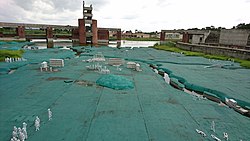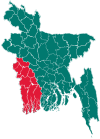Mujibnagar
Bhoborpara( Ex- Baidyanathtala) | |
|---|---|
 Mujibnagar Muktijuddho Smriti Complex | |
 | |
| Coordinates: 23°39′N 88°36′E / 23.650°N 88.600°E | |
| Country | |
| Division | Khulna |
| District | Meherpur |
| Area | |
| • Total | 112.68 km2 (43.51 sq mi) |
| Population (2011) | |
| • Total | 99,143 |
| • Density | 880/km2 (2,300/sq mi) |
| Time zone | UTC+6 (BST) |
| Postal code | 7102 |
| Website | mujibnagar |
Mujibnagar is an upazila (subdistrict) of Meherpur District in Bangladesh.
History
[edit]Mujibnagar was formerly a part of the Meherpur Sadar Upazila, before it was made a separate Upazila on 22 February 2000. The name Mujibnagar commemorates an event in the history of Bangladesh: It is the place where, on 17 April 1971, the first government of the People's Republic of Bangladesh was sworn in, and the place was named Mujibnagar after Bangabandhu Sheikh Mujibur Rahman.[1]
Geography
[edit]Mujibnagar Upazila is bounded by Meherpur Sadar Upazila in Meherpur District, on the north, Meherpur Sadar Upazila and Damurhuda Upazila, the latter in Chuadanga District, on the east, and Tehatta I CD Block, in Nadia District, West Bengal, India, on the south and the west.[1]
Demographics
[edit]| Year | Pop. (000) | ±% |
|---|---|---|
| 1981 | NA | — |
| 1991 | NA | — |
| 2001 | 90 | — |
| 2011 | 99 | +10.0% |
| Source: Bangladesh Bureau of Statistics[2] | ||
As of the 2011 Bangladesh census, Mujibnagar upazila had 24,602 households and a population of 99,143. 18,550 (18.71%) were under 10 years of age. Mujibnagar had an average literacy rate of 50.50%, compared to the national average of 51.8%, and a sex ratio of 1020 females per 1000 males. 10,021 (10.11%) of the population lived in urban areas.[2][3]
Administration
[edit]Meherpur Sadar Upazila is divided into four union parishads: Bagoan, Dariapur, Mahajanpur, and Monakhali. The union parishads are subdivided into 29 mauzas and 33 villages.[2]
References
[edit]- ^ a b Hossain, Md. Murad (2012). "Mujibnagar Upazila". In Islam, Sirajul; Jamal, Ahmed A. (eds.). Banglapedia: National Encyclopedia of Bangladesh (Second ed.). Asiatic Society of Bangladesh.
- ^ a b c d "Bangladesh Population and Housing Census 2011 Zila Report – Meherpur" (PDF). bbs.gov.bd. Bangladesh Bureau of Statistics.
- ^ "Community Tables: Meherpur district" (PDF). bbs.gov.bd. Bangladesh Bureau of Statistics. 2011. p. 103.

Well, that’s interesting to know that Psilotum nudum are known as whisk ferns. Psilotum nudum is the commoner species of the two. While the P. flaccidum is a rare species and is found in the tropical islands. Both the species are usually epiphytic in habit and grow upon tree ferns. These species may also be terrestrial and grow in humus or in the crevices of the rocks.
View the detailed Guide of Psilotum nudum: Detailed Study Of Psilotum Nudum (Whisk Fern), Classification, Anatomy, Reproduction